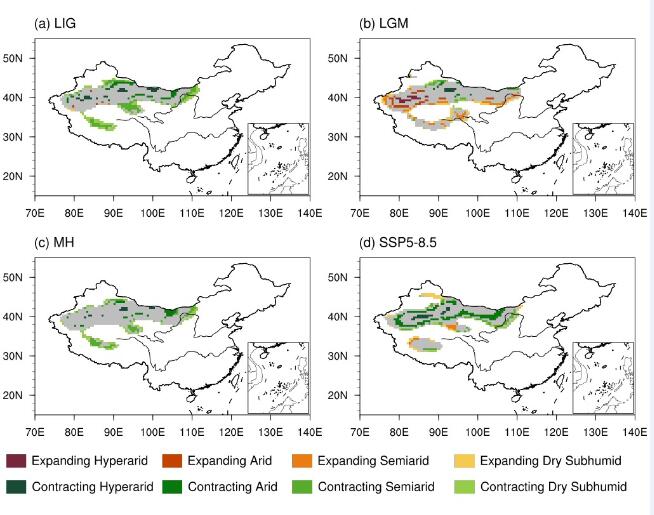联系我们
竺可桢-南森国际研究中心
邮 箱:nzc_iap@mail.iap.ac.cn
邮 编:100029
地 址:北京市朝阳区德胜门外祁家豁子华严里40号 竺南中心

科研进展
Research Progress中国过去到未来的旱地变化
Past to future drylands in China
[2023-05-31]
【中文介绍】
自工业革命以来全球持续变暖,与此同时,全球水文循环加速,干旱等极端天气和气候事件发生频率不断增加。旱地的扩张与旱情的加剧会抑制农业发展并对粮食保障产生威胁,因此,全面了解旱地在不同气候背景下的变化及其原因对于应对气候变化极为重要。然而,现有的器测资料时间较短,而且随着未来不断升温,未来气候必然会超过当前器测数据的极值。因此有必要在更长的时间尺度上分析古气候变化及机制,以提高我们对未来气候变化的理解并增加未来气候预估的可信度。
为此,课题组采用CMIP6多模式试验数据,基于干湿指数(AI:降水除以潜在蒸散发)研究了末次间冰期(距今约127000年前,是距离现在最近的暖期)、末次冰盛期(距今约21000年前,是最近一次冰盖范围最大的时期)、中全新世(距今约6000年前,最近一个间冰期)以及未来3种共享社会经济路径(SSP1-2.6、SSP2-4.5和SSP5-8.5)情景下中国的旱地变化及其物理机制。结果显示,相对于工业化革命前期,中国旱地总面积在末次间冰期、末次冰盛期和中全新世分别减少15%、增加6%和减少13%,在未来情景下则变化不大。在中国,降水变化主导了末次盛冰期旱地的扩张和未来旱地的收缩,潜在蒸散发主导了中全新世旱地的收缩,而降水和潜在蒸散发对末次间冰期旱地收缩的贡献相当。对于潜在蒸散发变化,温度在末次冰盛期和未来情景中起决定作用,而相对湿度在末次间冰期和中全新世为主导因子。尽管末次冰盛期和中全新世的重建记录还存在不确定性,模式模拟的中国干湿变化与地质记录总体一致。
【英文介绍】
Global warming has continued since the Industrial Revolution. Simultaneously, the global hydrological cycle has accelerated, the frequency of extreme weather and climate events, such as drought, has increased. The expansion of drylands and the intensification of aridification can inhibit agricultural development and endanger food security. Thus, it is necessary to fully understand dryland changes with various climate backgrounds and the underlying reasons. However, the instrumental data are relatively limited. With the acceleration of global warming, the future climate will be bound to exceed the extreme value of current instrumental data. Therefore, we need to analyze paleoclimate changes at longer time scales, particularly for periods when the climate change compared to the present was as large as the anticipated future change, to improve our understanding of future climate change and the credibility of future projections.
In this study, we investigate the aridity changes in China and the associated mechanisms during the last interglacial (LIG; the most recent warm period at approximately 127 ka BP), last glacial maximum (LGM; the recent period of the maximum extent of the ice sheet at approximately 21 ka BP), and mid-Holocene (MH; the latest interglacial period at approximately 6 ka BP), as well as the three future scenarios of the shared socioeconomic pathways of SSP1-2.6, SSP2-4.5, and SSP5-8.5 through aridity index (AI; a ratio between annual precipitation and potential evapotranspiration) by using CMIP6 multi-model simulations. The results show that relative to the preindustrial period, the total dryland area in China varies by −15%, 6%, and −13% during the LIG, LGM, and MH, respectively, and slightly varies in the three future scenarios. Over China, LGM dryland expansion and future dryland contraction are mainly attributed to precipitation changes, MH dryland contraction is mainly caused by PET changes, and LIG dryland contraction is comparably caused by PET and precipitation changes. Regarding the LGM and three future scenarios, temperature is the leading factor of PET changes, while during the MH and LIG, the change in relative humidity is the main factor. The simulated aridity changes in China are generally consistent with the reconstructed moisture changes for the three past periods, although uncertainties exist in reconstructions during the LGM and MH.
【关键图表】

【引用格式】
Shi, J., Z. Tian, X. Lang, and D. Jiang, 2023: Past to future drylands in China: A multimodel analysis using CMIP6 simulations. Journal of Climate, 36, 2735–2751, https://doi.org/10.1175/JCLI-D-22-0720.1.